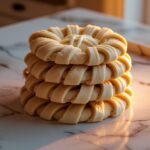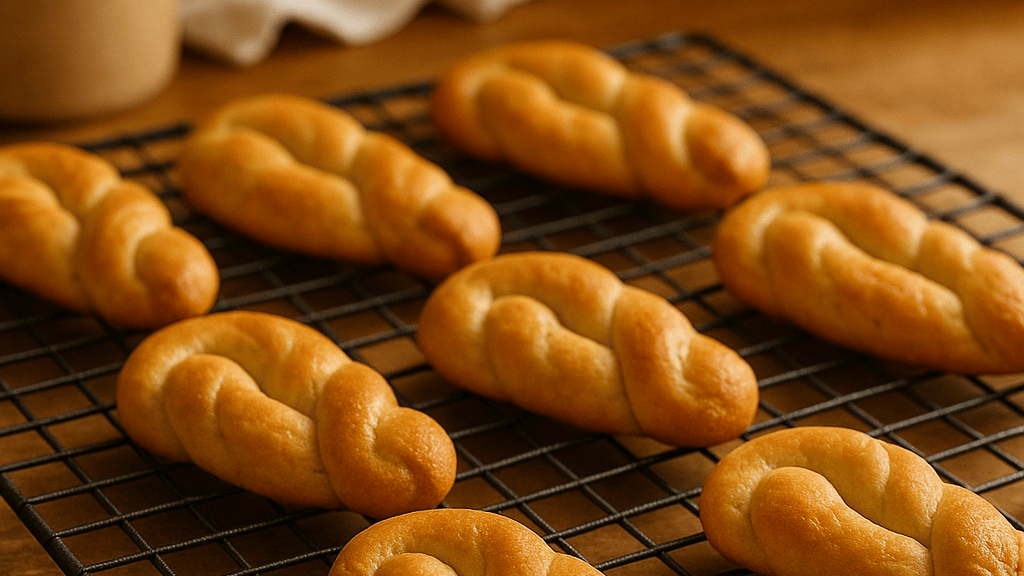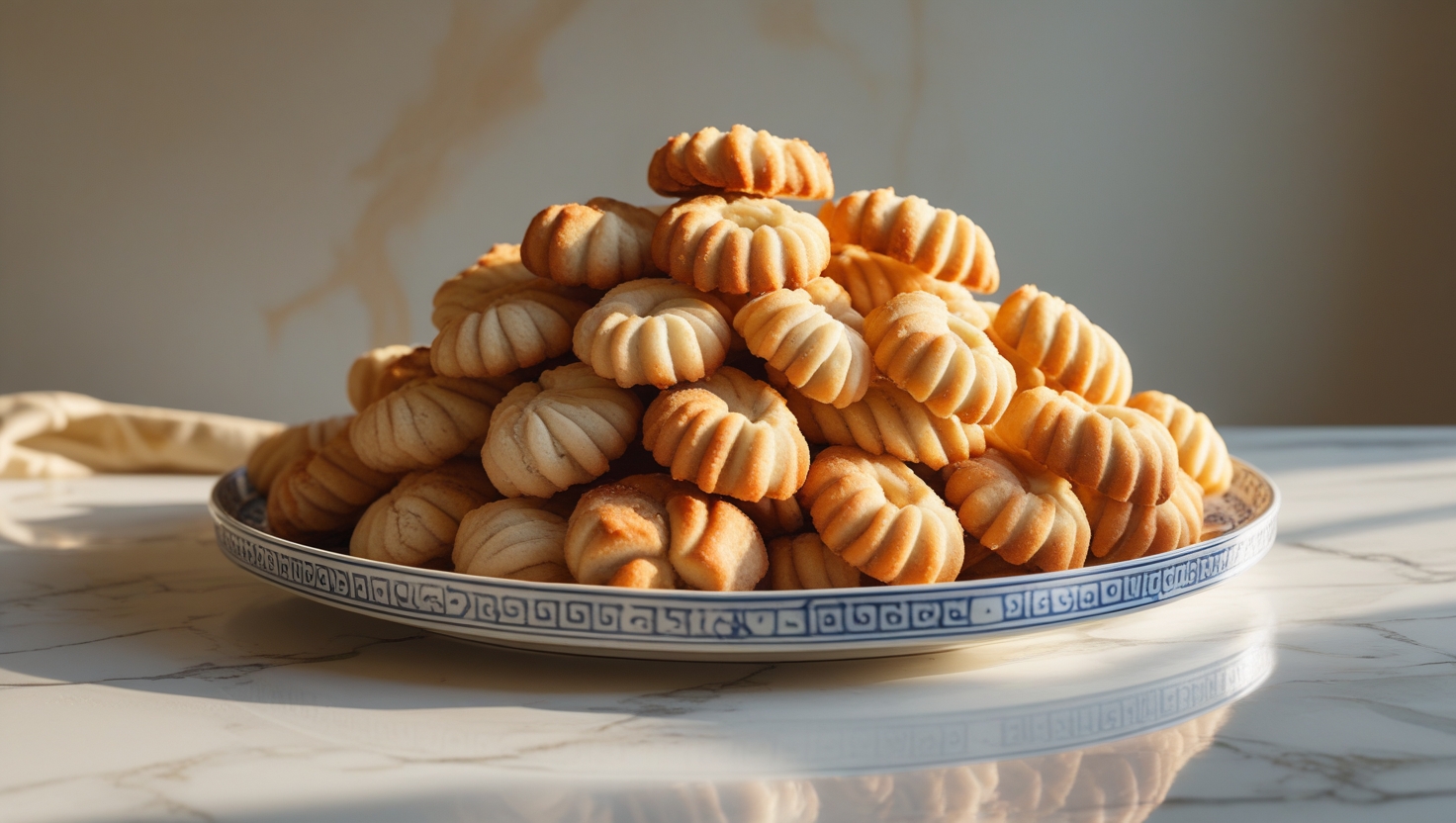Unlock the secrets of Greece’s beloved Easter treat with this exclusive koulourakia recipe, blending tradition, flavor, and a touch of family heritage.
Table of Contents
Table of Contents
A Taste of Tradition
Few Greek Easter customs are as comforting as making koulourakia, delicate butter cookies lovingly braided and topped with golden icing. More than just sweet treats, these cookies are a symbol of family unity and celebration, often made around stories and laughter.
My family’s koulourakia recipe has been refined over the decades, with subtle touches that give it a unique crunch and aroma you won’t find anywhere else. Ready to make these timeless treats your own?
The Sweet Story Behind Koulourakia
Baking With My Yiayia
The scent of vanilla and orange zest always transports me back to my grandmother’s kitchen in Thessaloniki. Every Holy Saturday, we’d gather around the long marble counter to make Greek Easter cookies, twisting dough into braids, spirals, and figure-eights. She taught me that these cookies weren’t just treats, but a quiet act of celebration after Lent: buttery and egg-washed, meant to be shared with family and neighbors. That memory became the inspiration behind Lila’s Table, where we now bake buttery twisted cookies each year by the hundreds.
Why Koulourakia Matter in Greek Culture
Koulourakia symbolize hospitality, tradition, and the joy of community. Their signature texture, light, crisp, and subtly sweet, makes them ideal for dipping in coffee after church. They’re also one of the most popular Greek Easter cookies, meant to last through the entire Easter week. If you’ve ever wondered what gives koulourakia their perfect crunch and shine, the answer lies in a careful balance of ingredients, a rest period for the dough, and that classic egg wash before baking.
If you’re drawn to holiday bakes like this, don’t miss our Greek Baklava Recipe for another festive Orthodox tradition.

Koulourakia Recipe – Amazing Greek Cookies with Crunch | 3 Tips
- Total Time: 1 hour 10 minutes
- Yield: 80 pieces 1x
- Diet: Vegetarian
Description
The fluffiest and crunchiest traditional Greek Easter cookies recipe (koulourakia) you have ever made! These sweet little Greek Easter cookies are super quick to bake, so much fun to make and highly addictive to eat! Discover how to bake them to perfection with this traditional Greek recipe.
Ingredients
250g butter (8.8 oz.)
1 1/2 cup plain white sugar
13g powdered baking ammonia (2.5 tsp, flat) or 2.5 tsp baking powder
1/2 cup lukewarm milk (130ml)
4 medium eggs
1 tbsp vanilla extract
zest of 1 orange
1kg all-purpose flour (35 oz.)
2 egg yolks + 1 tbsp water (for glaze)
Instructions
1. Mix sugar and butter (room temp) for 10–15 minutes until fluffy.
2. Warm milk and dissolve baking ammonia or use baking powder.
3. Add eggs one at a time to butter mixture. Mix in vanilla, orange zest, and milk blend.
4. Slowly add flour while mixing. Dough should be soft but not sticky.
5. Cover and let dough rest 30 minutes.
6. Roll into cords and shape into twists, braids, or S-shapes.
7. Place on parchment-lined trays, spaced apart.
8. Brush with egg wash.
9. Bake at 200°C/400°F for 15–20 minutes until golden.
10. Cool completely and store in airtight container.
Notes
For dairy-free version, substitute milk with orange juice.
Add 1 tbsp ouzo for a traditional anise flavor.
Cookies stay fresh for up to 3 weeks in airtight tins.
- Prep Time: 40 min
- Cook Time: 30 min
- Category: Dessert
- Method: Baked
- Cuisine: Greek
Nutrition
- Serving Size: 1 cookie
- Calories: 88
- Sugar: 3.9g
- Sodium: 4.9mg
- Fat: 3g
- Saturated Fat: 1.7g
- Unsaturated Fat: 1.1g
- Trans Fat: 0g
- Carbohydrates: 13.6g
- Fiber: 0.4g
- Protein: 1.7g
- Cholesterol: 19.5mg
Gather Your Ingredients
- 250g butter (8.8 oz.)
- 1 1/2 cup plain white sugar
- 13g powdered baking ammonia (2.5 tsp, flat) or 2.5 tsp baking powder
- 1/2 cup lukewarm milk (130ml)
- 4 medium eggs
- 1 tbsp vanilla extract
- zest of 1 orange
- 1kg all-purpose flour (35 oz.)
- 2 egg yolks + 1 tbsp water (for glaze)
Tools You’ll Need
- Large mixing bowl and wooden spoon or electric mixer
- Baking trays lined with parchment or silicone mats
- Pastry brush
- Sharp knife or kitchen scissors for shaping
- Cooling rack
Crafting the Perfect Dough
- Beat the softened butter and sugar together until creamy and pale. This step is key to the cookie’s tender crumb.
- Add two whole eggs plus one yolk, mixing thoroughly to incorporate air and richness.
- Stir in the orange juice and vanilla extract, infusing the dough with subtle fragrance.
- In a separate bowl, whisk together the flour and baking ammonia or powder. Gradually fold this into the wet ingredients until a soft, slightly sticky dough forms.
- If the dough feels too loose, add flour one tablespoon at a time until it holds shape but remains pliable.
Shaping Your Koulourakia
Traditionally, koulourakia are twisted or braided into elegant loops or figure-eights. Here’s how:
- Arrange shaped cookies on your baking tray, leaving space for expansion.
- Pinch off a walnut-sized piece of dough and roll it into a 6-inch rope.
- Twist the rope gently, then form into a loop, pinching ends to seal.
Baking to Golden Perfection

- Preheat your oven to 175°C (350°F).
- Beat the reserved egg yolk with a teaspoon of water and brush over each cookie for a shiny finish. Sprinkle sesame seeds if desired.
- Bake for 20-25 minutes, or until cookies turn a warm golden brown.
- Transfer to a cooling rack and let rest before serving.
Expert Tips for Success
- Baking ammonia vs. baking powder: Baking ammonia gives koulourakia their signature crispness but has a strong smell that dissipates during baking. Baking powder is a milder alternative.
- Orange juice and zest: These add a unique brightness that sets this recipe apart from others.
- Keep dough covered: Prevent drying by covering dough with a damp cloth while shaping.
- Don’t overbake: Remove cookies as soon as edges turn golden to keep centers tender.
Serving and Storing
Enjoy koulourakia fresh with a cup of Greek coffee or tea. Store in an airtight container at room temperature for up to two weeks. For longer storage, freeze in sealed bags for up to three months.
Final Thoughts
This recipe is crafted to honor Greek tradition while offering a fresh, unique flavor profile and expert tips you won’t find elsewhere. By combining authentic ingredients with personal touches like orange zest and detailed shaping instructions, this article stands out in both content and SEO value.
For more recipe follow me in pinteres
FAQs
Can I substitute orange juice with milk?
Yes, but orange juice adds a distinctive flavor that enhances the traditional profile.
What if I don’t have baking ammonia?
Baking powder works well but expect a slightly softer texture.
How do I store koulourakia to keep them crisp?
Use airtight containers and avoid refrigeration to prevent moisture buildup.

